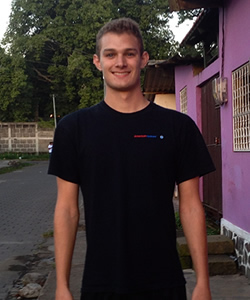
Sam Gyory
Sam Gyory (C'15) graduated from Georgetown College in 2015 with a major in mathematics. He participated in the Berkley Center's Junior Year Abroad Network while studying in Nicaragua for the fall 2013 semester.
With buses, taxis, cars, motorcycles and bicycles flooding the streets of Nicaragua, one cannot cross the street without looking both ways—this rule even holds true in the small town of Diriamba where I am currently living. This is largely due to the fact that few Nicaraguans have the luxury of owning their own vehicle, thus relying on public transportation to reach any destination beyond their town’s borders.
There is no train system within Nicaragua, only two types of buses—a buzon (what appears to be a classic American school bus) or a microbus (a large van). However, the high demand for public transportation has lead the owners to redesign the interiors by installing hand rails along the aisles of the buzones and squeezing one or two extra rows of seats in both the microbuses and the buzones. I will never forget the older American I had met the first week of my trip laughing about the pace of public transportation, “right when you think they can’t fit one more person on the bus, ten more people get on.” Advice that always makes me smile when an adult is instructed to sit on my lap during an hour-long trip back to Diriamba.
To be completely honest, I was incredibly nervous to use public transportation for the first time in Nicaragua. However, after many had reassured me that it was safe for a foreigner to take a bus, I worked up the courage (granted I was traveling alone) to take a buzon back to the city where I was staying. A kind stranger helped me flag down the bus with the cobradore (driver’s assistant) hanging out the front door yelling “Rivas, Rivas” in a singsong voice. As the bus slowed to a stop, the back door swung open and the other cobradore beckoned me inside. The bus was almost completely full, and I tentatively sat on the edge of the seat where the other passenger was leisurely spread out in the middle, refusing to move an inch. As the ride progressed, I became more relaxed and quickly amused by the pace of the journey. When a passenger wanted to get off, they would signal the driver, the driver would slow down—never stop—and the person would have to quickly jump off while the bus was still rolling. When a passenger would like to transport their bicycle, the bikes are put on top of the bus. For this, the cobradores would constantly climb onto the roof while the bus is still in motion to have to bike ready for the passenger while the bus was still rolling. In addition, passengers boarded the bus with anything from (live) chickens to handmade jewelry that they were planning on selling in the neighboring market. While comical and entertaining, my first bus ride turned out to be an accurate reflection of Nicaraguans' use of public transportation.
Through the use of public transportation, I have come to learn a lot about the life of Nicaraguans. The high demand for public transportation is due to the fact that many people do not work near where they live. Unlike Americans, Nicaraguans tend to stay in the same town, usually next door to their parents or even within the same complex. That being said, many jobs and universities are located within the capital city Managua—and those who do not live in the city must turn towards public transportation to perform their daily obligations. Some who live farther from the city, or where public transportation is scarce, are forced to rent rooms out of Managuans’ homes, only to return to their own on the weekends. Putting this in terms of a student’s perspective, they are forced to travel between one and three hours to get to their daily classes.
These remarks are not meant to harbor feelings of guilt, and I do not think they should be looked at negatively. This intricate and frequently used system of public transportation comments on Nicaragua’s ability to develop. For example, I heard a story about a woman who travels two and a half hours to sell a typical and common food from her region in an area where the dish is much harder to find. This shows that people are continually gaining more access to jobs, educational opportunities, or exposure to other communities and ways of life. It may mean a long, cramped ride in a hot van, but people are doing it. Furthermore, the more creative and entrepreneurial the population becomes, while using the available resources—public transportation for example—the country will continue to develop and expand around these newly created opportunities.